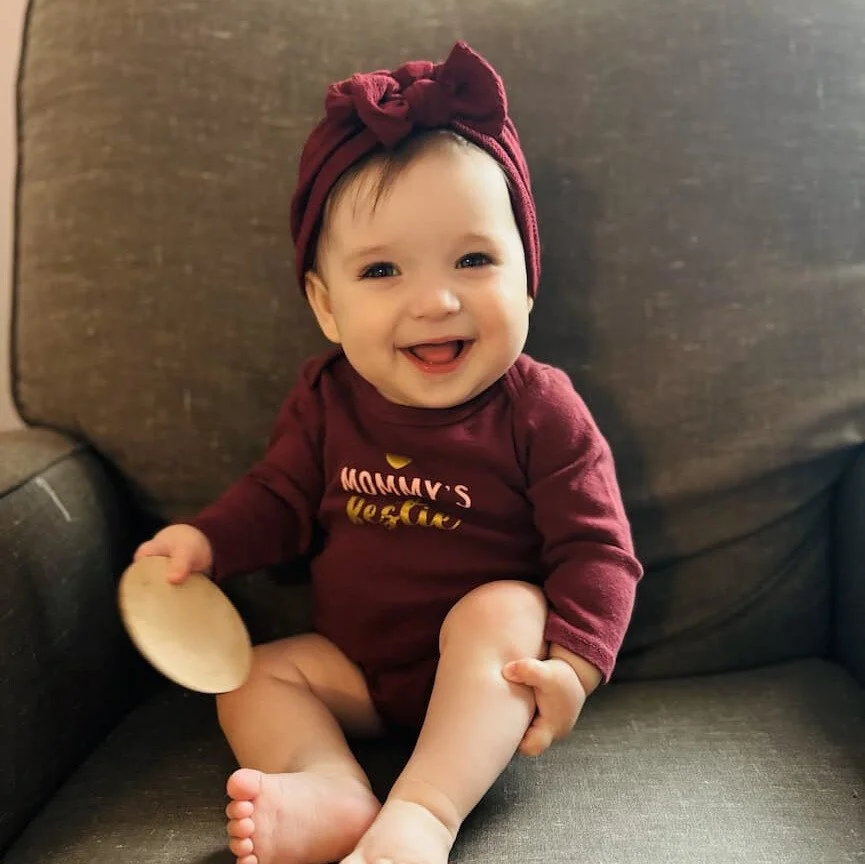Noelle’s Type 1 Cleft Journey
By Lindsay Marshall
Noelle is a unicorn baby. She always smiles, rarely cries, and sleeps through the night.
She is a unicorn baby in another way, too. From birth, she could not eat.
We syringe fed her at first, and after a week found a single type of bottle (Philips Avent) that she could latch on. But every feed was a battle. Noelle would eat only tiny amounts at a time. It would take an hour to feed her only an once or two, with many breaks for her to fuss. She always sounded congested after eating. And she choked. She would stop breathing, and we would frantically pound her back, begging her to breathe.
We took her to the pediatrician and their lactation consultant. They didn’t see the urgency. “She just has an immature suck.” “Babies gag.” “Give her time.” But the days went by, and she never got any better.
When she was a month old, we took her to a new lactation consultant. After trying her tips for a week, she very gently told us that this case was above her paygrade and referred us to a feeding therapist. The feeding therapist could see that Noelle’s swallow was not functioning as it should, and roped in an ENT, Dr. Kaelan Black, to help us order a swallow study to learn more.
The swallow study showed that Noelle was aspirating whenever she swallowed. We were told to thicken Noelle’s milk to “mildly thick” with a powder called GelMix, to ask the ENT about something called a laryngeal cleft, and sent out the door.
We felt like the rug had been pulled out from under us. All this time she had been struggling with something much more than an “immature suck.” All this time we thought Noelle was congested, we had actually been hearing the milk or even saliva she had swallowed rattle around her airway.
And now we had to figure out how to manage the very finicky process of thickening her bottles. We needed to add GelMix, heat it to 100 degrees, and wait for it to become “mildly thick.” How in the world were we supposed to tell whether her milk had reached “mildly thick”? How could we possibly leave the house between the pumping and the heating and the mixing?
We did what any other parent would do – we took to the internet. We read the small amounts that sites like WebMd and the Mayo Clinic had to offer. We read dozens of scholarly articles on laryngeal clefts. And we found an online community of parents to other laryngeal cleft babies who could share their experiences with us.
When Noelle was four months and ten days old, she underwent a laryngoscopy, a surgery during which Dr. Black peered into her airway to see if she had a laryngeal cleft or not. After a short stint in the operating room, Noelle emerged with a diagnosis of a laryngeal cleft type 1. Dr. Black had temporarily filled it so we could see whether repairing the cleft would help.
Almost immediately after surgery, Noelle was a brand new baby. For the first time in her life, she enjoyed eating. She would reach for the bottle! Down a whole bottle in one go! She put on weight like a champion. That showed us everything we needed to know – we needed the permanent fix.
Noelle underwent surgery to permanently repair her cleft when she was nine months old with Dr. Black at Fairfax Inova Children’s Hospital in Fairfax, Virginia. It was more difficult than we were expecting, and she needed some time in the PICU on a ventilator to help her fully recover. It has only been a short time since she has come home, and she is already showing us some changes – she is eating every solid food we throw at her!
We know that this is only the beginning of Noelle’s journey. She has other conditions that laryngeal clefts are known to be associated with, namely low muscle tone and a heart defect. But we are hopeful that life with a repaired cleft will make Noelle’s journey an easier one.

